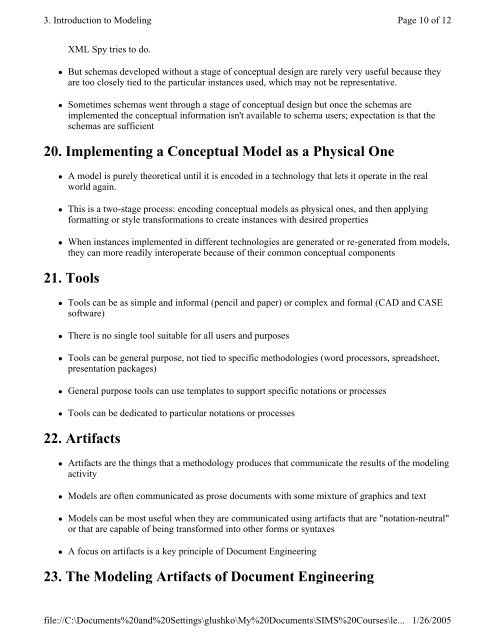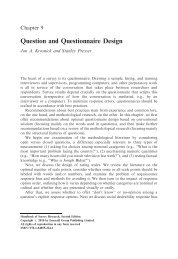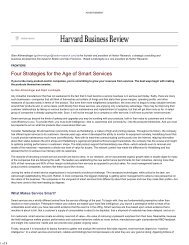3. Introduction to Modeling 1. Plan for Today's Class 2 ... - Courses
3. Introduction to Modeling 1. Plan for Today's Class 2 ... - Courses
3. Introduction to Modeling 1. Plan for Today's Class 2 ... - Courses
You also want an ePaper? Increase the reach of your titles
YUMPU automatically turns print PDFs into web optimized ePapers that Google loves.
<strong>3.</strong> <strong>Introduction</strong> <strong>to</strong> <strong>Modeling</strong><br />
Page 10 of 12<br />
XML Spy tries <strong>to</strong> do.<br />
• But schemas developed without a stage of conceptual design are rarely very useful because they<br />
are <strong>to</strong>o closely tied <strong>to</strong> the particular instances used, which may not be representative.<br />
• Sometimes schemas went through a stage of conceptual design but once the schemas are<br />
implemented the conceptual in<strong>for</strong>mation isn't available <strong>to</strong> schema users; expectation is that the<br />
schemas are sufficient<br />
20. Implementing a Conceptual Model as a Physical One<br />
• A model is purely theoretical until it is encoded in a technology that lets it operate in the real<br />
world again.<br />
• This is a two-stage process: encoding conceptual models as physical ones, and then applying<br />
<strong>for</strong>matting or style trans<strong>for</strong>mations <strong>to</strong> create instances with desired properties<br />
• When instances implemented in different technologies are generated or re-generated from models,<br />
they can more readily interoperate because of their common conceptual components<br />
2<strong>1.</strong> Tools<br />
• Tools can be as simple and in<strong>for</strong>mal (pencil and paper) or complex and <strong>for</strong>mal (CAD and CASE<br />
software)<br />
• There is no single <strong>to</strong>ol suitable <strong>for</strong> all users and purposes<br />
• Tools can be general purpose, not tied <strong>to</strong> specific methodologies (word processors, spreadsheet,<br />
presentation packages)<br />
• General purpose <strong>to</strong>ols can use templates <strong>to</strong> support specific notations or processes<br />
• Tools can be dedicated <strong>to</strong> particular notations or processes<br />
22. Artifacts<br />
• Artifacts are the things that a methodology produces that communicate the results of the modeling<br />
activity<br />
• Models are often communicated as prose documents with some mixture of graphics and text<br />
• Models can be most useful when they are communicated using artifacts that are "notation-neutral"<br />
or that are capable of being trans<strong>for</strong>med in<strong>to</strong> other <strong>for</strong>ms or syntaxes<br />
• A focus on artifacts is a key principle of Document Engineering<br />
2<strong>3.</strong> The <strong>Modeling</strong> Artifacts of Document Engineering<br />
file://C:\Documents%20and%20Settings\glushko\My%20Documents\SIMS%20<strong>Courses</strong>\le...<br />
1/26/2005
















